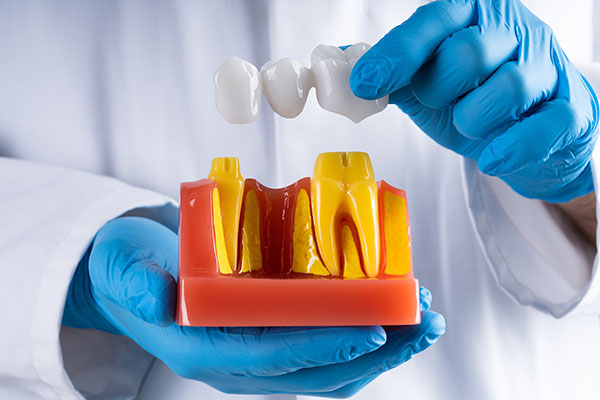Restore Your Smile With Dental Bridge Solutions
Missing teeth can significantly impact your ability to speak properly, chew food comfortably, and smile with confidence. If you’re looking for a dentist near you to replace missing teeth, dental bridges offer a proven and effective solution that can improve your oral health and overall quality of life. At Brown and Baran Family Dentistry, our experienced Wilmington and Seaford dentists specialize in creating custom dental bridges that look, feel, and function like your natural teeth.
Ready to restore your smile? Contact our dental professionals today at our Wilmington dental office at (302) 999-7600 or our Seaford dental office at (302) 536-7589. We proudly serve patients throughout Wilmington, Seaford, Pike Creek, and surrounding Delaware communities with comprehensive dental bridge solutions.
What Are Dental Bridges?
Dental bridges are sophisticated prosthetic devices designed to “bridge” the gap created by one or more missing teeth. These custom-crafted restorations consist of artificial teeth (called pontics) that are permanently anchored to your existing teeth or dental implants, creating a seamless replacement for your missing teeth.
Modern dental bridges utilize advanced materials and techniques to ensure your restoration blends naturally with your surrounding teeth while providing the strength and durability needed for everyday functions like eating and speaking.
Why Choose Brown and Baran Family Dentistry?
At Brown and Baran Family Dentistry, our approach to dental bridges combines artistic precision with dental excellence. Dr. Paul Brown and Dr. Chris Baran create custom bridges that restore your smile’s appearance and its full functionality.
- Experienced Team: Our skilled dentists have extensive experience in restorative dentistry and stay current with the latest techniques and materials.
- Advanced Technology: We utilize state-of-the-art equipment and digital imaging for precise, comfortable treatment.
- Personalized Care: Every patient receives individualized attention and customized treatment plans.
- Convenient Locations: Two convenient offices in Wilmington and Seaford, DE, serving the greater Delaware area.
- Comprehensive Services: From consultation to final placement and ongoing maintenance, we provide complete dental bridge care.
Our experienced dentists offer durable, comfortable dental bridges, customized to blend seamlessly with your natural teeth and restore confidence. Call our Wilmington, DE office at (302) 999-7600 or our Seaford, DE office at (302) 536-7589 for a consultation.
Types of Dental Bridges Available Near You
Please note: we may not provide some of these dental bridge options at Brown and Baran Family Dentistry.
Traditional Dental Bridges
Traditional bridges are the most common type of dental bridge, ideal when you have healthy natural teeth on both sides of the gap. This permanent bridge solution involves placing dental crowns on the abutment teeth (surrounding teeth) to support the artificial teeth in between.
Best for: Replacing one to three consecutive missing teeth when adjacent teeth are healthy and strong enough to support the bridge.
Cantilever Dental Bridge
A cantilever bridge is used when only one adjacent tooth is available to support the replacement tooth. This type of bridge is less common but can be effective in specific situations where traditional bridges aren’t feasible.
Best for: Situations where only one abutment tooth is available, typically in the back of the mouth, where chewing forces are manageable.
Maryland Dental Bridge
Maryland bridges utilize a metal or porcelain framework with metal wings that bond to the back of your existing teeth. This conservative approach requires minimal preparation of your natural teeth, making it an excellent option for younger patients.
Best for: Replacing front teeth where aesthetics are crucial and preserving the structure of adjacent teeth is important.
Implant-Supported Bridge
An implant-supported bridge represents the gold standard in tooth replacement. Instead of relying on natural teeth for support, these bridges are anchored to dental implants surgically placed in your jawbone.
Benefits of implant-supported bridges:
- No impact on surrounding teeth
- Prevents bone loss in the jaw
- Most durable and long-lasting option
- Easiest to maintain with proper oral hygiene
Life-Changing Benefits of Dental Bridges
Patients looking to replace missing teeth can experience many advantages from dental bridges that extend far beyond aesthetics:
- Restored chewing ability: Enjoy all your favorite foods without discomfort
- Improved speech: Eliminate lisping or slurring caused by missing teeth
- Enhanced comfort: No more food particles getting stuck in gaps
- Prevents tooth shifting: Stops remaining teeth from moving into empty spaces
- Maintains facial structure: Preserves your natural facial contours and prevents premature aging
- Protects oral health: Reduces the risk of gum disease and tooth decay in adjacent areas
- Supports overall health: Proper nutrition through improved chewing function
- Restored confidence: Smile, laugh, and speak without self-consciousness
- Professional appearance: Maintain a polished look in work and social situations
- Improved quality of life: Enjoy social dining experiences without worry
The Dental Bridge Procedure at Our Wilmington and Seaford Offices
Consultation and Planning
Before the dental bridge procedure, we’ll schedule a consultation. During your initial visit to our Wilmington or Seaford office, our dentist will:
- Conduct a comprehensive oral health examination
- Take digital impressions and X-rays
- Discuss your treatment options and answer your questions
- Create a personalized treatment plan
Preparation Phase
If you’re receiving a traditional bridge, we’ll carefully prepare your abutment teeth by removing a small amount of enamel to accommodate the crowns. You’ll receive a temporary bridge to protect your teeth and maintain your appearance while your permanent bridge is crafted in our dental lab.
Final Placement
Once your custom bridge is ready (typically two to three weeks), you’ll return for the final placement. We’ll ensure a perfect fit, comfort, and aesthetics before permanently cementing your bridge in place.
Post-Treatment Care
After your bridge placement, we’ll provide detailed instructions for maintaining your new restoration and schedule follow-up appointments to ensure optimal healing and function.
Dental Bridge Costs in Wilmington and Seaford
The cost of dental bridges varies based on several factors, with most patients investing between $2,000 and $5,000 for their restoration. Factors affecting cost include:
- Type of bridge: Traditional bridges vs. implant-supported options
- Materials used: Porcelain, zirconia, or metal components
- Number of teeth: How many teeth need replacement
- Additional procedures: Any preparatory treatments needed
- Geographic location: Wilmington, DE area pricing
- Dental insurance: Coverage varies by plan
Financing Options Available: We accept most dental insurance plans and offer flexible payment options to make your dental bridge treatment affordable.
Are You a Candidate for Dental Bridges?
You may be an excellent candidate for dental bridges if you have:
- One or more missing teeth
- Healthy gums and good oral hygiene habits
- Sufficient bone structure to support the bridge
- Realistic expectations about the treatment outcome
Our dentist will assess the health of your adjacent teeth and gums, ensuring they are strong enough to support the bridge and free from disease. Additionally, they will evaluate your bite alignment, oral hygiene habits, and bone density to ensure the long-term success and proper support of the restoration.
Dental Bridge Alternative Options
If dental bridges aren’t suitable for your situation, we may recommend:
- Dental implants: Individual tooth replacement without affecting adjacent teeth
- Partial dentures: Removable option for multiple missing teeth
- All-on-4 implants: Full-arch replacement for extensive tooth loss
Frequently Asked Questions
With proper care and regular dental check-ups, dental bridges typically last 10-15 years. Advanced materials like zirconia can extend this lifespan to 20+ years. Implant-supported bridges often last even longer due to their superior stability and support.
Absolutely! Modern dental bridges are crafted to match your natural teeth in color, shape, and size. Advanced materials like multi-layered zirconia provide natural-looking results with improved translucency that blend seamlessly with your smile.
Most patients experience minimal discomfort during the procedure, which is performed under local anesthesia. Some mild sensitivity or soreness may occur after treatment, but this typically resolves within a few days with over-the-counter pain relievers.
The entire process typically takes two to four weeks from your first appointment to final placement. We provide a temporary bridge during this time to protect your teeth and maintain your appearance.
Schedule Your Dental Bridge Consultation Today
Don’t let missing teeth impact your quality of life any longer. Our experienced team at Brown and Baran Family Dentistry is ready to help you explore your tooth replacement options and restore your confident smile.
Contact us today to schedule your consultation at our Wilmington dental office at (302) 999-7600 or our Seaford dental office at (302) 536-7589. Serving patients throughout Delaware with comprehensive restorative dentistry solutions. We look forward to helping you achieve the healthy, beautiful smile you deserve!




